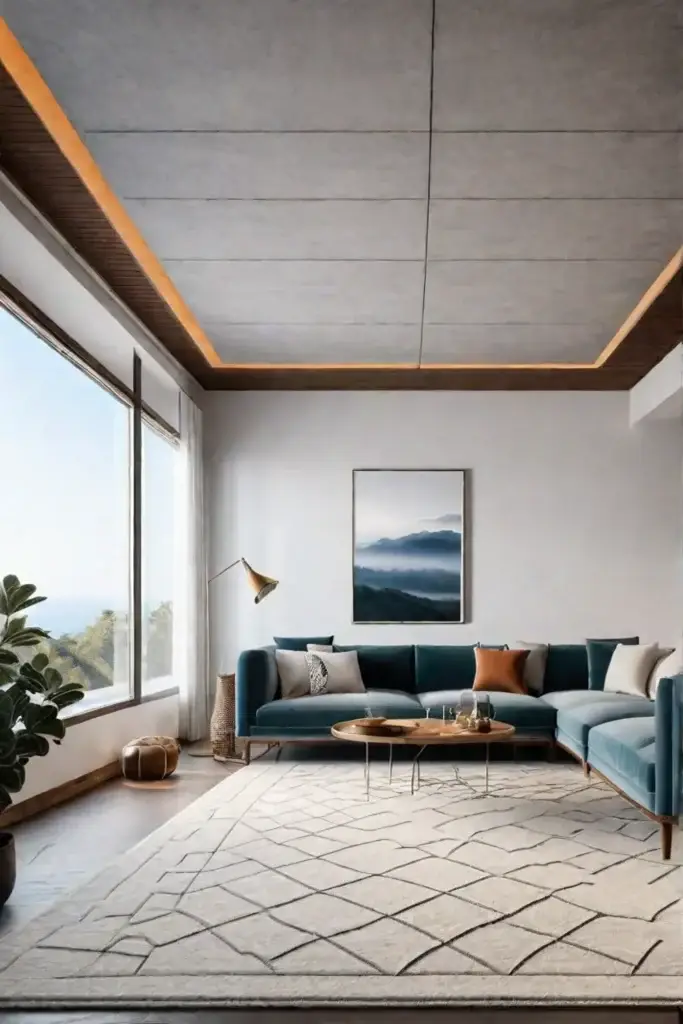Are you tired of feeling cramped and overwhelmed in your living room? Do you long for a space that exudes calm and tranquility? Look no further—the secret to creating the perfect minimalist living room lies in mastering a few key design principles.
As a marketing manager at a tech startup, I know firsthand the challenges of decorating a small city apartment on a budget. But through trial and error, I’ve discovered that less can truly be more when it comes to living room design. By focusing on elements like color, furniture, natural light, and open space, you can transform your living room into a serene oasis that feels stylish and inviting.

In this article, we’ll explore the art of minimalist living room design, guiding you through creating a space that exudes space and serenity. Get ready to say goodbye to clutter and hello to a living room that’s as functional as beautiful.
Color Palettes: The Foundation of Minimalist Design
Establishing a calming and cohesive color palette is the foundation of a minimalist living room. Neutral tones like white, beige, and gray are the show’s stars, creating a clean, uncluttered look that allows your furniture and decor to shine.
But don’t be afraid to add a few strategic pops of color! A touch of blue or green can add visual interest without overwhelming the space. The key is finding the perfect balance, ensuring that your color scheme is harmonious and visually appealing.

One of my favorite tricks is incorporating natural materials like wood and stone. Not only do they complement the neutral color palette, but they also add warmth and texture to the room. And when you pair these natural elements with the right lighting, you can create a truly breathtaking space.
Furniture Choices: Functional and Visually Harmonious
In a minimalist living room, every piece of furniture must serve a purpose and contribute to the overall aesthetic. I’m a big fan of multi-functional and versatile pieces, like convertible sofas or modular shelving units. These items not only save space but also help to create a cohesive and visually harmonious look.
Regarding furniture, the focus should be on clean lines, simple silhouettes, and minimal ornamentation. Avoid anything too bulky or ornate, as it can quickly overwhelm the space. Instead, opt for streamlined and visually appealing pieces, like a sleek mid-century modern coffee table or a minimalist armchair.

And don’t forget about the importance of scale and placement. Carefully arranging your furniture can make all the difference in how your living room feels. Creating a sense of flow and balance can enhance the perception of space and make the room feel more open and inviting.
Maximizing Natural Light: The Key to Serenity
Natural light is the key to creating a serene, inviting, minimalist living room. By strategically positioning your furniture and incorporating large windows or sliding glass doors, you can flood the space with natural illumination, making it feel bright, airy, and oh-so-calming.
But it’s not just about letting the light in but also how you use it. Light-colored materials and finishes, like white walls or a light-colored rug, can help to reflect and amplify the natural light, creating the illusion of a larger and more open space.

And let’s not forget about the psychological and physiological benefits of natural light exposure. Studies have shown that natural light can improve mood, increase productivity, and reduce stress. So, not only will your living room look and feel amazing, but it will also positively impact your overall well-being.
Embracing Open Space: The Art of Minimalist Living
At the heart of minimalist living room design is open space. By minimizing clutter and unnecessary furnishings, you can create a sense of spaciousness and flow that’s truly transformative.
But it’s not just about removing items – it’s also about how you arrange the furniture. By strategically placing your pieces, you can promote a sense of openness and movement, making the room feel more inviting and serene.

And let’s not forget about the design elements that can help create the illusion of a larger space. Mirrors, glass, and light colors are all powerful tools in the minimalist designer’s arsenal, allowing them to visually expand the room and make it feel more open and airy.
Balancing Texture and Simplicity
The balance between texture and simplicity is key in a minimalist living room. While the overall aesthetic may be clean and uncluttered, natural textures and subtle patterns can add depth and warmth to the space.
Think about incorporating natural materials like wood, stone, or linen. These elements contribute to the minimalist aesthetic and add a sense of coziness and comfort. And when you balance these textural elements with clean-lined, minimalist furnishings, you create a harmonious and visually appealing space.

Don’t be afraid to get creative with your accents, either. A woven rug, a plush throw, or a textured wall covering can all add visual interest without overwhelming the room. The key is to use these elements sparingly, ensuring that they complement the overall minimalist aesthetic rather than competing with it.
Personalizing Your Minimalist Living Room
While minimalism emphasizes simplicity, that doesn’t mean your living room has to be devoid of personal touches and accents. In fact, incorporating meaningful elements can help make the space feel warm, inviting, and uniquely yours.
When selecting decorative accents, focus on pieces that align with your minimalist color palette and overall aesthetic. A few carefully curated artworks or personal mementos can add a touch of personality without compromising the clean and uncluttered look you’re going for.

And don’t be afraid to get creative with the placement of your accents, either. Grouping items in odd numbers or using negative space to highlight a particular piece can create visual interest and draw the eye to the things that matter most.
Lighting Strategies for Minimalist Living Rooms
Lighting is crucial in any minimalist living room. It can enhance the sense of openness, create a calming atmosphere, and highlight key design elements. The key is to combine ambient, task, and accent lighting to achieve the perfect balance.
When it comes to light fixtures, look for pieces with clean, simple designs that complement the minimalist aesthetic. Recessed lighting or flush-mounted fixtures can help to create a seamless, integrated look, while dimmable lighting allows you to adjust the mood and ambiance to suit your needs.

Remember the strategic placement of your lighting. Accent lighting can highlight artwork or architectural features, while task lighting can provide illumination for specific activities like reading or working.
Bringing Nature into the Minimalist Living Room
Finally, let’s discuss the power of incorporating natural elements into your minimalist living room. By introducing materials like wood, stone, and greenery, you can create a sense of serenity and connection to the great outdoors—even in the heart of the city.
Low-maintenance, air-purifying plants like snake plants or peace lilies are a great way to add a natural touch without too much visual clutter. Natural wood or stone accents, such as a coffee table or side table, can also add warmth and texture to the space.

The key is ensuring these natural elements seamlessly integrate with the minimalist aesthetic. By carefully selecting and placing your natural accents, you can create a living room that feels both serene and stylish.
Conclusion: Embracing the Art of Minimalist Living
Ultimately, the art of minimalist living room design is all about finding the perfect balance between simplicity, functionality, and personal expression. By thoughtfully curating your color palette, furniture choices, natural light, and open space, you can create a living room that exudes a sense of calm and serenity – a true oasis in the heart of your home.
So, what are you waiting for? Start decluttering, rearranging, and incorporating those natural touches. Your minimalist living room awaits, and I can’t wait to see what you create!






